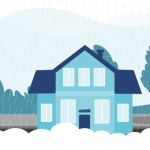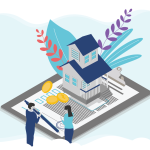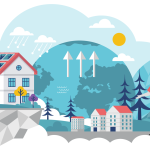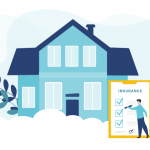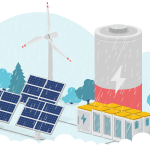Severe Weather Events: Is Your Home Covered?
September 3, 2024
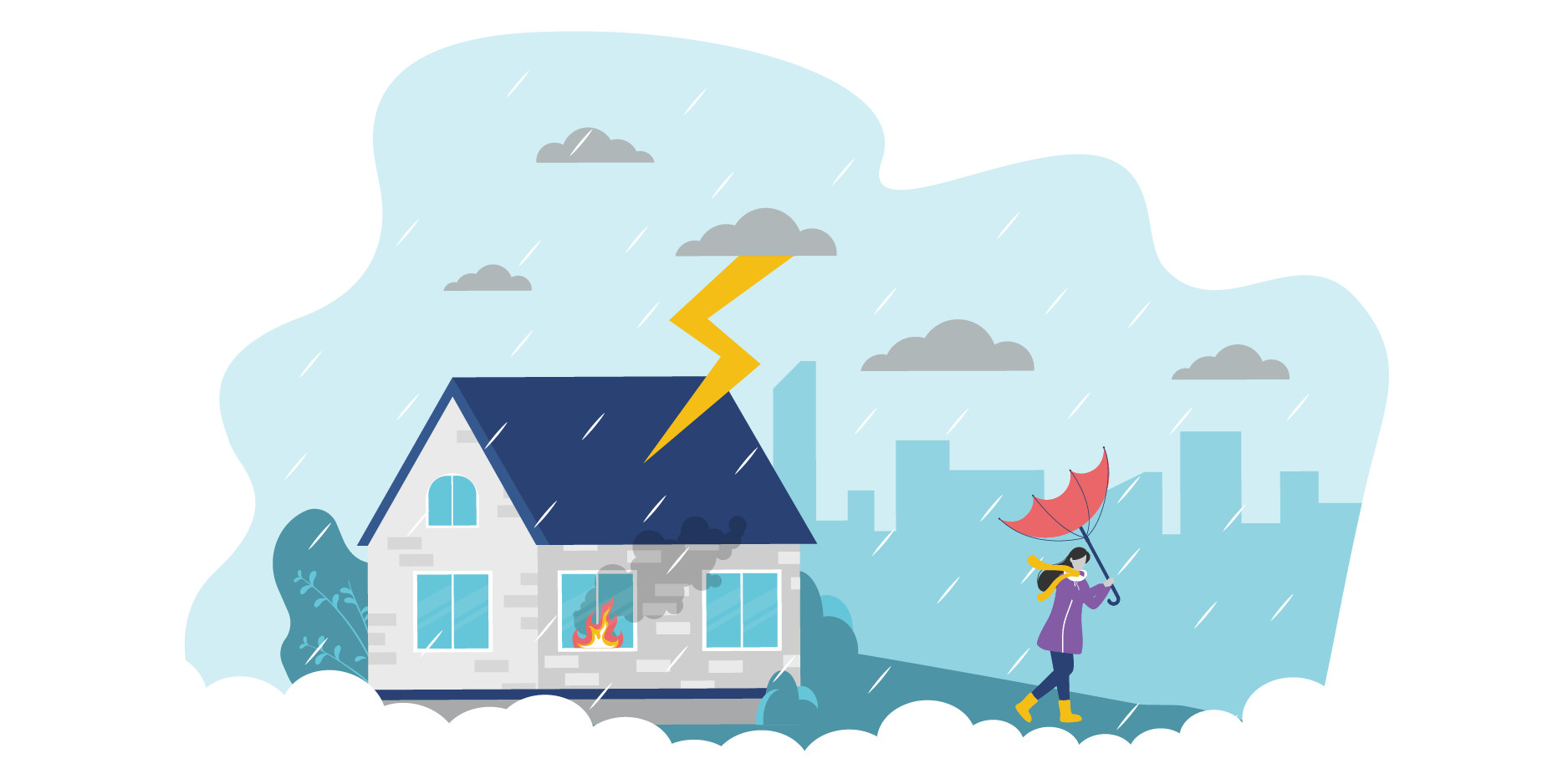
Canada has faced a series of extreme weather events over the past year, from spring ice storms to extensive wildfires to rain-induced flooding. With the ongoing effects of climate change, we shouldn’t count on these events slowing down anytime soon—and their impact is being felt across various areas, including the insurance industry.

Most recently in July 2024, the unprecedented rainfall and flooding across southwestern and eastern Ontario led to an estimated $1 billion in residential and commercial damage and Alberta wildfires are estimated to have destroyed 30% of the structures in Jasper, causing up to $700 million in insured losses.
As extreme weather events are becoming a more frequent part of life, insurance companies are facing an influx of claims, leading to changes in coverage options, premium costs, and the overall approach to risk management. Keep reading to learn more about how exactly your Home Insurance could be impacted, as well as our top tips to protect yourself in an increasingly unpredictable environment!
How do severe weather events affect your insurance coverage?
The frequency and cost of claims related to weather events are on the rise, and insurance companies are responding by limiting coverage and raising premiums to cover the higher risk of damage. So if you live in a region that’s deemed more at risk of storms, floods, wildfires, or other natural disasters, finding affordable coverage—or any coverage at all—could become more difficult.
Higher deductibles could be introduced for claims related to severe weather, which means you’ll need to pay more out-of-pocket before your insurance policy kicks in. Specific types of weather-related damage could be excluded altogether. For example, standard home insurance policies often exclude flooding, requiring homeowners to purchase separate Flood Insurance, if it’s even available for their region. Insurance companies might also consider implementing stricter criteria to qualify for coverage, such as requiring regular detailed inspections or preventative measures, like reinforced roofing or a sump pump.
Whether you live in a vulnerable area or not, filing more property damage claims following a storm might boost your risk profile from the perspective of your insurer. And the riskier your property, the higher your premiums.
How can I protect myself?
1. Do your due diligence before purchasing a home.
One factor that you should never overlook when house hunting is location—and we’re not just talking about what schools or shopping malls are nearby, we’re talking about the risk level of your environment. If the area you’re looking to move to is prone to storms, flooding, or wildfires, you might have trouble securing affordable insurance coverage for those perils. And that’s not something that realtors are eager to let you know about, so it’s crucial to do your own research on the area of a home you’re interested in purchasing!
If you’re looking to move at any point in the future, check out our list of 12 Things You Shouldn’t Ignore Before Buying a Home to help you ensure that your dream home doesn’t end up becoming a nightmare.
RELATED: 8 Tips to Protect Your Property From Wildfires
2. Stay prepared for changing weather conditions.
It never hurts to stay informed. As climate change continues to affect us all, educate yourself on the conditions that can lead to severe weather—especially if you live in proximity to a flood or fire zone.
Keep up with your local weather network and news stations for weather-related updates and notices. Know your evacuation routes, develop an emergency preparedness plan within your household, and have an emergency kit stocked with enough supplies to keep your family safe and self-sufficient for at least 3 days.
RELATED: How Does Your Claims History Affect Your Home & Auto Insurance?
3. Don’t slack on home maintenance.
Regular upkeep of your home could do wonders when it comes to mitigating damage sustained in a storm. Keep an eye out for small issues around the house and patch them up before they escalate into something worse—the last thing you want is to be scrambling to get everything done right before a natural disaster hits.
Another great reason to maintain your home, regardless of severe weather warnings? Your coverage likely won’t extend to any damage or deterioration caused by normal wear and tear. Remember: Home Insurance is meant to protect you from emergencies that can’t be avoided, not losses that could have been prevented.
RELATED: 12 Fall Home Maintenance Tips
4. Keep your valuables protected.
Be sure to store your valuables, important documents, and anything irreplaceable (like family heirlooms) in a water- and/or fireproof container in a safe spot on the highest level of your home to reduce the likelihood of damage in case of a severe weather event.
If you don’t already have one, create a documented home inventory list of all of your valuable possessions, including photos and receipts. We won’t deny that it’ll likely take a few hours of work—but knowing the value of your contents will help you avoid any gaps in your insurance policy, as well as allow you to easily identify what needs to be replaced if you’re ever affected by a natural disaster.
To aid you in starting the process, we’ve put together an electronically fillable home inventory checklist here.
RELATED: 4 Signs Your Home May Be Underinsured
5. Review your insurance policy.
Insurance companies are looking to mitigate their own risk levels in the wake of big losses, so it’s never been more important to review your policy to identify any weather-related gaps in coverage. Understanding exactly what your Home Insurance includes—and what it doesn’t—can make all the difference when you need it the most.
Most standard policies cover losses from rain, snow, hail, wind, and fire, but you might need to purchase additional specialized covered for damage caused by:
- Overland Water: Above ground overflow from rivers, lakes, and reservoirs as a result of excessive rainfall, snow/ice melting, or dam breaks.
- Groundwater: Underground water that enters homes through basements or sudden/accidental foundation cracks when the water level rises.
- Sewer Backup: Clogged drains or overflowing city sewers that back up into your home.
- Certain Natural Disasters: While some events like wildfires might be covered for most homeowners, others like earthquakes/earth movements, hurricanes, tornadoes, and volcanic eruptions are generally excluded.
If you’re looking to add specific coverage to your policy for any of the above items, connect with your broker to learn more about what’s available to you.
6. Work with a broker.
Did you know that each insurance company has their own unique method of calculating risk? That’s why it’s crucial to shop around when it comes to insurance, because one insurer could classify you as medium risk, while another could consider you low risk. Not to mention that each insurance company offers a different selection of coverage options, and you’ll need to invest time and energy into researching the choices out there in order to secure the policy that suits you best. But what if you know you’re too busy to do your due diligence? Or if insurance feels like a foreign language to you, and you just don’t know where to start?
Let a broker, like PROLINK, do the heavy lifting on your behalf. As an independent insurance broker, we aren’t limited to options from just one insurance company—and we’ll put your best interest first, not the insurer’s. We have strong partnerships with multiple insurance providers, allowing us to look at all of the options on the market to guide you towards the best policy for your unique needs. We’ll help you make informed decisions regarding your coverage, and provide risk prevention tips to reduce the likelihood of future claims, even in the face of climate change.
RELATED: 5 Advantages of Using an Independent Insurance Broker
It’s no surprise that the rising frequency of natural disasters could affect your insurance coverage and claims in one way or another. But with PROLINK by your side, you’ll have a dedicated advisor in your corner—no matter what uncertainties come your way. From comparing quotes on your behalf to supporting you through an otherwise stressful claims process, our team is dedicated to ensuring you’re as protected as possible. With over 40 years in business and access to a wide network of over 30 insurance providers, we have the know-how to help you secure the right coverage, from the right insurer, at the right price.
To learn more, connect with PROLINK today!
PROLINK’s blog posts are general in nature. They do not take into account your personal objectives or financial situation and are not a substitute for professional advice. The specific terms of your policy will always apply. We bear no responsibility for the accuracy, legality, or timeliness of any external content.
